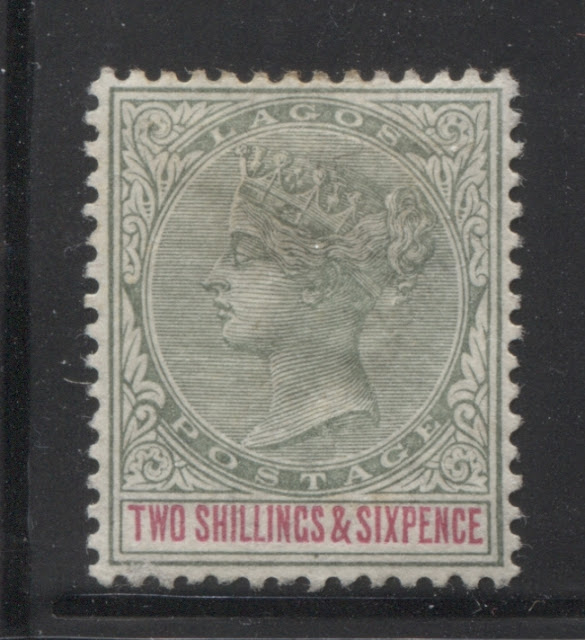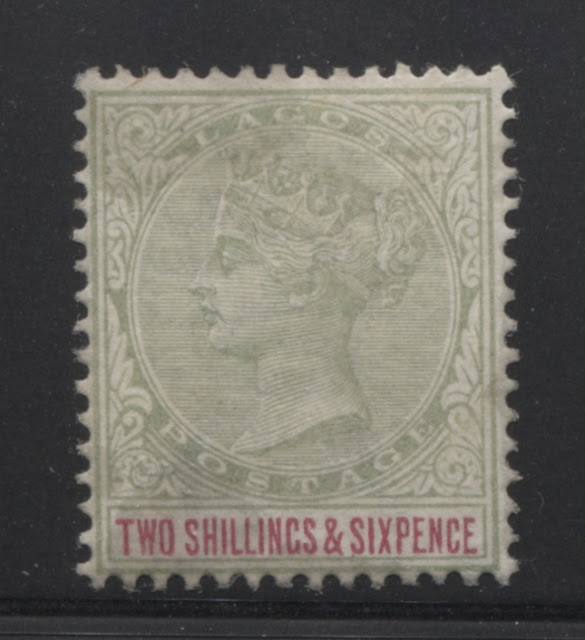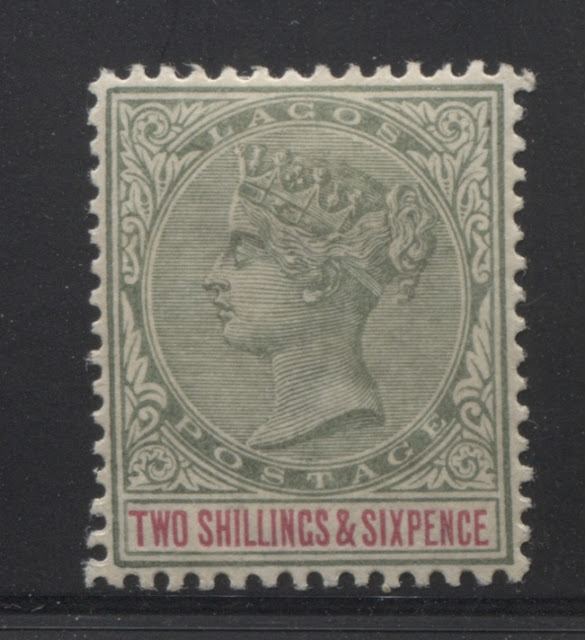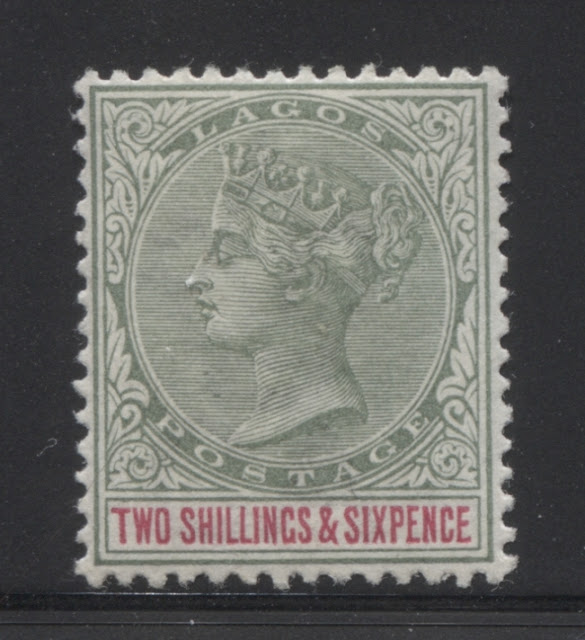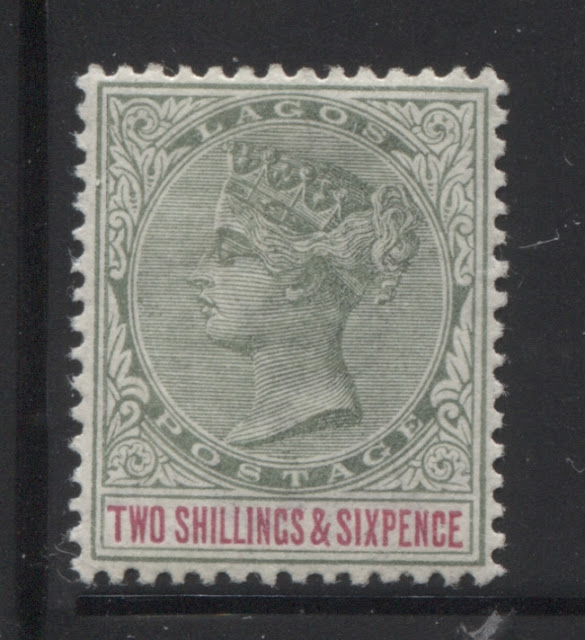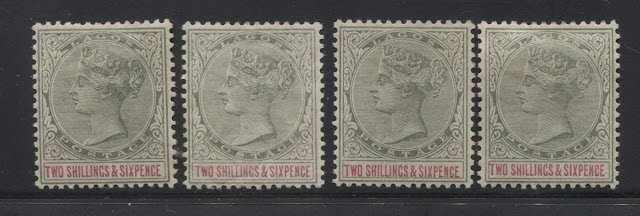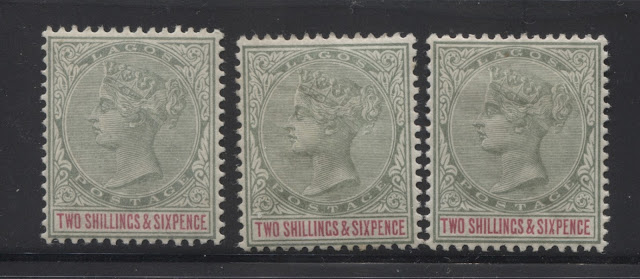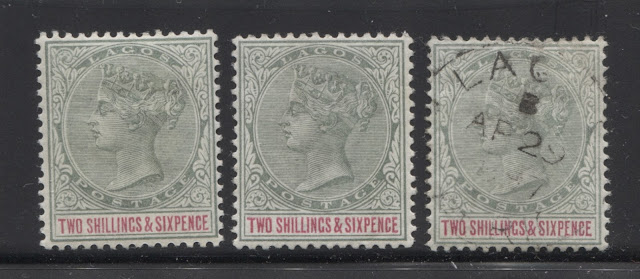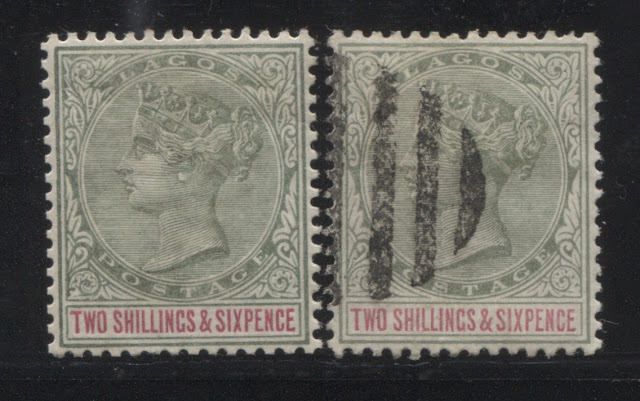Today's post will look at the first of the three high value stamps from this issue. According to Ince, the total number of stamps printed and sent to the colony between March 31, 1887 and August 19, 1901 was 28,260 stamps, of which 18,060 were sent back to London in 1905 and destroyed. This leaves a mere 10,200 stamps that were sold and either used for postage, or preserved in mint condition. If we assume a survival rate in all grades of 10%, which is likely very generous, given that this is a West African crown colony, and not England or Canada, or some other country with a temperate climate and a population that is accustomed to preservation, then there are probably no more than 1,000 stamps in existence now - both mint and used.
A denomination of this size would have seen little postal use, being used only for registered letters that had a high insurance value, larger parcels or bulk mailing receipts. This was a revenue issue as well, since it was inscribed "postage and revenue", and so some stamps would have seen revenue use, though interestingly, I have not come across many examples with fiscal cancellations, which suggests that they were not often used for this purpose, unlike the high value stamps of many other colonies were. Thus it is likely that many fewer printings were made, perhaps as few as 14 and as many as 20, but unlikely more than this. Given the low rate of usage, it would be my expectation that there would be many late usages as stamps from the "bottom of the post office drawer" finally got sold and used up. Consequently, I would expect the remainder total of 18,060 stamps to have come from a large number of the printings that were left over when the next supply was received by post offices and placed on top of the old stamps.
I have 42 stamps in total of this value in my collection. Three of these are mildly affected by water and one is severely affected and is of limited use in identifying specific printings. As before, I will look at the different states of the plate and then at the head and duty plate shades.
As it turns out, I did identify 20 separate printings:
A denomination of this size would have seen little postal use, being used only for registered letters that had a high insurance value, larger parcels or bulk mailing receipts. This was a revenue issue as well, since it was inscribed "postage and revenue", and so some stamps would have seen revenue use, though interestingly, I have not come across many examples with fiscal cancellations, which suggests that they were not often used for this purpose, unlike the high value stamps of many other colonies were. Thus it is likely that many fewer printings were made, perhaps as few as 14 and as many as 20, but unlikely more than this. Given the low rate of usage, it would be my expectation that there would be many late usages as stamps from the "bottom of the post office drawer" finally got sold and used up. Consequently, I would expect the remainder total of 18,060 stamps to have come from a large number of the printings that were left over when the next supply was received by post offices and placed on top of the old stamps.
I have 42 stamps in total of this value in my collection. Three of these are mildly affected by water and one is severely affected and is of limited use in identifying specific printings. As before, I will look at the different states of the plate and then at the head and duty plate shades.
As it turns out, I did identify 20 separate printings:
- 4 from the first state of the plate (approximately March 1887 - about 1890).
- 5 from the second state (1890 to about 1893).
- 8 from the third state (1894 to about 1899).
- 3 from the fourth state (1899 to 1900).
I have not seen any examples from the fifth state of the plate, though according to Ince, the last printings were sent on August 19, 1901, so they should exist. The implication of the fact that at least 20 printings were made, is that it is quite likely that no more than 50 or 60 copies of each printing still exist today, though it is more likely that a few of the common printings exist in greater quantity and that the scarcer ones exist in less quantity. At any rate, these are extremely scarce stamps in any grade. Postally used examples are at least 10 times scarcer than mint and examples having their full original colour are likely 30-40 times scarcer than mint. So even though they are priced higher than mint in Gibbons, they are still vastly undervalued in my opinion.
There were almost four years from 1887 through to the end of 1890, which suggests one printing per year. From 1890 to the end of 1893 is 4 years again, which suggests 1 or 2 printings per year. From 1894 to 1899, it seems that almost 2 printings per year were sent, with maybe one sending every third quarter or so. Then from 1899 to 1901 it likely decreased back down to 1 printing or so per year.
This post will discuss the first 9 printings, from the first two states of the plate.
Printings 1-4 From the First State of the Plate (March 1887 to Approximately 1890)
As stated in all my earlier posts, the first state of the plate is characterized by nearly all of the fine detail in the hair, jewels and diadem being clearly visible and with little to no merging of the hairlines at the top of the head, and most detail of the hair at the very back of the head visible both above and below the diagonal ribbon.
First Printing
The head plate shade on this printing is similar to Gibbons's dull green, but it is deeper. It is not however, deep enough to be the deep dull green. So I would call it deeper dull green - a shade about mid-way between those two colours on the Gibbons key. The duty plate colour is closest to carmine, but is paler.
This is a badly faded example that has been regummed. I have assigned it to this printing on the basis of the lack of plate wear, and the fact that the duty plate colour matches that of this printing. This was likely a fiscally used example that was cleaned to remove the cancel and regummed. In the process of cleaning, the ink has been faded to the point of being a very light yellow green, as this doubly fugitive ink is wont to do.
Second Printing The head plate colour of this printing is an almost perfect match to Gibbons's deep green. The duty plate colour is a perfect match to Gibbons's carmine shade.
Third Printing
The head plate colour of this printing contains a bluish undertone. Not quite enough to be the blue green or dull blue green, but more than the deep dull green. It actually is closest to what Gibbons's myrtle green would be if it were pale. So I would call this the pale myrtle green. The duty plate shade is closest to Gibbons's bright carmine.
Fourth Printing
The head plate colour of this printing is closest to Gibbons's deep dull green, but is perhaps a tad paler. The duty plate colour is closest to Gibbons's deep carmine.
The mint example above bears the specimen overprint of the period, indicating that it was for UPU distribution. The overprint shows a dot in the bottom loop of the "S" and a blob inside the left lower leg of the "M".
Printings 5-9 From the Second State of the Plate (1890 to Approximately the End of 1893)
In the second state of the plate, the detail is similar to the first state, except that there is a slight loss of sharpness to the detail and the beginning of some merging of the hairlines, though very, very little.
Fifth Printing
The head plate colour of this printing is a near perfect match to Gibbons's deep dull green, but with a hint more bluish undertone. The duty plate colour has a bluish undertone, similar to Gibbons's carmine-lake, but just a bit paler.
Sixth Printing
The head plate colour of this printing, like the second printing, is Gibbons's deep green. The duty plate colour is closest to Gibbons's lake shade, but a little bit paler and duller.
I have four mint examples of this printing, as shown here, but still no postally used examples.
Seventh Printing
The head plate shade of this printing is closest to Gibbons dull green, but is just a touch deeper. The duty plate colour has reverted back to Gibbons's carmine shade. Again, I have three mint examples, but no used ones.
Eighth Printing
The head plate colour of this printing is similar to the dull green, but with a bluish tone. It is not quite blue enough to be the dull blue green however. It is closest to what the pale myrtle green of the third printing looks like, but it is just a bit duller. So I would call this the pale dull myrtle green. The duty plate shade here is closest to Gibbons's bright crimson.
This is the first printing in which I have a postally used example. This one appears to have been cancelled with a 24 mm Lagos CDS dated April 29, 1897, so it is a late usage, just as I expected would occur.
Ninth Printing
The head plate colour, once again, is closest to deep green. The duty plate colour is closest to Gibbons's rose carmine, but slightly deeper.
I have one mint example and a nice used example canceled with a partial strike of an 8-bar Lagos oval obliterator.
This brings me to the end of my discussion of the first 9 printings of this stamp. Next week I will cover the remaining 11 printings.


